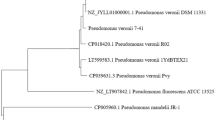Abstract
The growth ofRhodococcus opacus GM-14 on mixtures of 2-chloro- and 2-bromophenol, of 4-chloro, 4-bromo-, and 4-iodophenol, and of chloro-, bromo-, and iodobenzenes was accompanied by the consumption of the substrates and the excretion of halogen ions into the medium. During the growth on monochlorophenols, the substrates were consumed sequentially in the following order: 4-chloro-, 3-chloro-, and then 2-chlorophenol. Chlorine ions were excreted in a two-phase manner in amounts comprising 79% of the theoretical yield. The diauxic growth ofR. opacus GM-14 can be explained by the existence in this bacterium of two modified metabolic pathways for theortho- cleavage of halogenated pyrocatechols. The first pathway included 4-halogeno- or dihalogenopyrocatechols as intermediates, whereas the second pathway included 3-halogenopyrocatechols.
Similar content being viewed by others
References
Kozyreva, L.P. and Golovleva, L.A., Growth ofNocardioides simplex on a Mixture of 2,4,5-T and 2,4-D Herbicides,Mikrobiologiya, 1993, vol. 62, pp. 189–192.
Brunsbach, F.R. and Reineke, W., Degradation of Chlorobenzoates in Soil Slurry by Special Organisms,Appl. Microbiol. Biotechnol., 1993, vol. 39, pp. 117–122.
Brunsbach, F.R. and Reineke, W., Degradation of Chloroanilines in Soil Slurry by Specialized Organisms,Appl. Microbiol. Biotechnol., 1993, vol. 40, pp. 402–407.
Brunsbach, F.R. and Reineke, W., Degradation of Chlorobenzenes in Soil Slurry by a Specialized Organism,Appl. Microbiol. Biotechnol., 1994, vol. 42, pp. 415–420.
Brunsbach, F.R. and Reineke, W., Degradation of Mixtures of Chloroaromatic Compounds in Soil Slurry by Mixed Cultures of Specialized Organisms,Appl. Microbiol. Biotechnol., 1995, vol. 43, pp. 529–533.
Golovleva, L.A., Zaborina, O.E., and Arinbasarova, A.Yu., Degradation of 2,4,6-TCP and Mixture of Isomeric Chlorophenols by ImmobilizedStreptomyces rochei 303,Appl. Microbiol. Biotechnol., 1993, vol. 38, pp. 815–819.
Haigler, B.E., Pettigrew, C.A., and Spain, J.C., Biodegradation of Mixtures of Substituted Benzenes byPseudomonas sp. Strain JS150,Appl. Environ. Microbiol, 1992, vol. 58, pp. 2237–2244.
Hollender, J., Dott, W., and Hopp, J., Regulation of Chloro- and Methylphenol Degradation inComamonas testosteroni JH5,Appl. Environ. Microbiol., 1994, vol. 60, pp. 2330–2338.
Puhakka, J.A., Herwig, R.P., Koro, P.M., Wolfe, G.V., and Ferguson, J.F., Biodegradation of Chlorophenols by Mixed and Pure Cultures from Fluidized-Bed Reactor,Appl. Microbiol. Biotechnol., 1995, vol. 42, pp. 951–957.
Zaitsev, G.M., Uotila, J.S., Tsitko, I.V., Lobanok, A.G., and Salkinoja-Salonen, M.S., Utilization of Halogenated Benzenes, Phenols, and Benzoates byRhodococcus opacus GM-14,Appl. Environ. Microbiol., 1995, vol. 61, pp. 4191–4201.
Tsitko, I.V., Zaitsev, G.M., Lobanok, A.G., and Salkinoja-Salonen, M.S., Effect of Aromatic Compounds on Cellular Fatty Acids Composition ofRhodococcus opacus, Appl. Environ. Microbiol., 1999, vol. 65, pp. 853–855.
Zaitsev, G., Uotila, J., Tsitko, I., Lobanok, A., and Salkinoja-Salonen, M., Microbial Catabolism of Halogenated Benzenes, Phenols, and Benzoates byRhodococcus rhodochrous Strain GM-14, Abstracts of Papers,7th Int. Congr. on Bacteriology and Applied Microbiology Division, Prague, Int. Union Microbiol. Soc., Singapore, 1994, p. 533.
Zaitsev, G.M., Tsitko, I.V., Uotila, J.S., and Salkinoja-Salonen, M.S., Initial Steps in the Metabolism of Mono- and Dichlorinated Benzenes and Phenols byRhodococcus opacus GM-14,Environmental Research in Finland Today, Second Finnish Conf. on Environmental Sciences, Saski, E. and Saarinen, T., Eds., Helsinki: Hakapaino Oy, 1995, pp. 205–207.
Zaitsev, G.M., Tsitko, I.V., Lobanok, A.G., Vazhinskaya, I.S., and Chechenin, V.P., Utilization of Halogenobenzenes byRhodococcus rhodochrous, Dokl. Acad. Nauk Belarus, 1993, vol. 37, pp. 65–68.
Bergmann, J.G. and Sanik, J., Determination of Trace Amounts of Chloride in Naphtha,J. Anal. Chem., 1957, vol. 29, pp. 241–243.
Standard Methods for the Examination of Water and Wastewater, 17th Ed., Clesceri, L.S.et al., Eds., Washington: American Public Health Association, 1989.
Moiseeva, O.V., Lin’ko, E.V., Baskunov, B.P., and Golovleva, L.A., Degradation of 2-Chlorophenol and 3-Chlorobenzoate byRhodococcus opacus 1cp,Mikrobiologiya, 1999, vol. 68, no. 4, pp. 461–466.
Author information
Authors and Affiliations
Rights and permissions
About this article
Cite this article
Zaitsev, G.M., Surovtseva, E.G. Growth ofRhodococcus opacus on mixtures of monohalogenated benzenes and phenols. Microbiology 69, 401–405 (2000). https://doi.org/10.1007/BF02756763
Received:
Issue Date:
DOI: https://doi.org/10.1007/BF02756763




